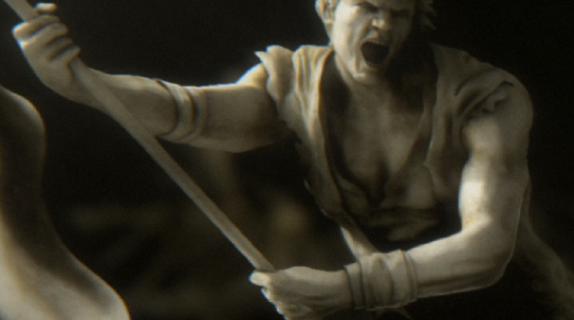One of the more thrilling title sequences to hit the airwaves in 2014 belongs to Starz’ “Black Sails,” though not for the expected reasons. Opening a show set in the cutthroat world of 18th-century pirates, one might predict a swashbuckling affair, rife with high-flying, plank-walking, sabre-clashing kinetic energy, be it live-action or other. But the titles by Imaginary Forces produce a sensation that might be considered the direct opposite of rousing adventure: sheer, unadulterated dread.
Marta Fernandez, SVP of original programming for Starz, called the opening “representative of the series in that they’re both very unique and challenge the viewers’ expectations of what they think they’ll see from a pirate show. There’s beauty in the title sequence but it also mirrors how the series gets darker and more violent as it progresses.”
That balance of beauty and encroaching darkness is exceptionally difficult to pull off under any circumstances, but particularly impressive when considering the way in which Imaginary Forces struck it – via a meticulous, unhurried journey through an ivory landscape of intricately carved Baroque filigree. As the camera slow-pans past unmoving statues of skeletons, cannons, galloping steeds, and even a giant squid, a kind of graveyard is evoked, a memoriam of a long-dead time, and terrible deeds once done.
From the giant, intricately detailed pirate ship centerpiece to the close-ups of the vessel’s crew, often screaming into the darkness, the artwork on display in “Black Sails’” opening looks palpably real when in fact it was made entirely using computer graphics. The Imaginary Forces team drew from an extensive cache of period-specific art research, weaving together such far-reaching references as Rodin’s sculpture “The Gates of Hell,” Parisian sarcophagi, and even the Statue of Liberty. The resulting pastiche feels simultaneously familiar and utterly unique, as Bear McCreary’s dirge-like score and the steadily rising ocean push the ghostly figures toward their inevitable, watery demise.

Brief had a few questions for Imaginary Forces about how they went about using computers to create artwork on the screen that looks real enough to touch. The sequence’s core team of co-directors Michelle Dougherty and Karin Fong, and art director Alan Williams, emailed the answers back, writing as a singular creative force.
BRIEF: Where does the process begin of using CG to create what appears to be photographed museum-quality sculptures?
IMAGINARY FORCES: We had a pretty involved process of texturing, lighting and compositing that creates that photo-real look. Our lead look development artist Joseph Langmuir worked on getting the textures right by fleshing out examples we liked and then the team hand-painted (via Mari) nearly every texture map so the pieces would feel unique. We lit each scene separately to bring out the most of each model, really pushing the details to highlight the intricacy of each model and texture.

For we who are unfamiliar with how computer graphics work, let’s hone in one figurine as an example. Does an actual sculptor assist with inputting and creating the CG images? Does one of your CG artists have a background in Baroque? Or can a great CG artist recreate any artistic style with enough research, etc.?
Our CG artists are all extremely talented. The modelers have worked on many sorts of projects and have an appreciation of art – many of them actually have a classical art background. The pirate scene was sketched by pencil first. Then the modeler took that sketch and modeled (using ZBrush) all of the men into place just as if a sculptor would sculpt something out of clay (in fact, one of our CG modelers IS an actual sculptor). We went through many iterations of this.

At the beginning, because we generally tend to have a modern sensibility of what people should look like, the pirates were almost too much like actors from the show, not classic Baroque sculptures you’d find from the 17th or 18th centuries. So we still had to do a lot of homework and study the most talented sculptors of the world. We then used the research we conducted to apply the proportions and details of classical sculpture to help them read as period pieces – for instance, the noses are longer and more Romanesque, the hair is not too wispy, the hands are bigger, the faces fuller.
How do you create the slow-panning camera movements for something like this?
We placed the CG objects in a 3D space and moved the camera just as we would if we were filming an actual statue. We really wanted to use restraint with each camera movement, and create tension throughout the piece.
Is every aspect of this CG? Are there any live-action elements?
Yes, every aspect of this is completely CG. At the beginning of the project we definitely entertained the idea of shooting things practically, but in the end, the only practical way to do this with the tight schedule we were given was to go CG. It took a leap of faith that we think really paid off!

Tags:













































__twocolumncontent.jpg)











